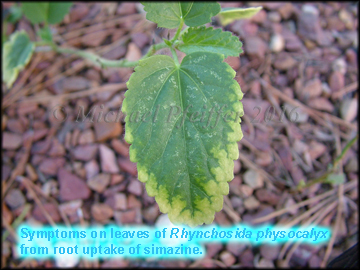|
There are three major chemical groups of herbicides which are termed photosynthesis inhibitors: the phenyureas (e.g. diuron and linuron), triazines (e.g. atrazine, prometone and simazine) and uracils (e.g. bromacil and terbacil).
These herbicides affect plants by binding to the D1 protein on chloroplast membranes which blocks electron flow during photosynthetic reactions. Singlet oxygen is produced which attacks cell membranes.
Even though these herbicides stop photosynthetic reactions, death of plants is from the rupturing of cell membranes. Most herbicides in this group have good to excellent activity by root uptake
but many also have foliar activity. A few herbicides in this group only have foliar activity: e.g. bentazone, bromoxynil, and pyridate.Persistance varies from weeks to months depending on the rate and soil pH. Most of these herbicides are more active and persist longer in low organic, high pH soils. Groundwater contamination has been
problematic with some of these compounds.
|









